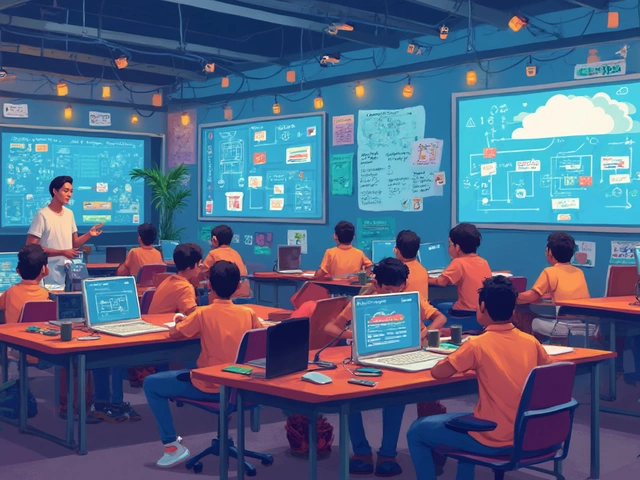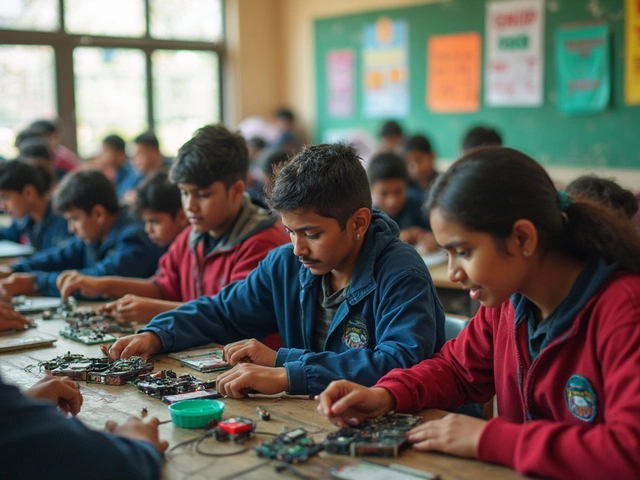Here’s something a lot of people don’t realize: you can kickstart a career in India with a diploma, and you don’t need a college degree for most options. More families are seeing diplomas as a fast track to jobs, especially in fields like design, IT, health care, and skilled trades.
But here’s the thing—figuring out how to get started gets confusing. There’s a maze of course names, application forms, entrance exams, and random deadlines. If you’ve felt lost scrolling through college websites, you’re not alone. Even when my cousin Elodie started looking at nursing diplomas, it felt like we needed a project manager just to keep track of everything.
Let’s break down how you can actually get a diploma in India, step by step. First, you need to know the types of diplomas—some take just 6 months, others two years. Then there’s eligibility: do you need to finish class 10, or class 12? Next, you want to pick a trustworthy institute (there are more fake colleges out there than you think—careful!). Finally, you need to know how to apply without missing those tricky deadlines.
- Types of Diploma Courses in India
- Eligibility and Admission Process
- Choosing the Right Institute
- Application Tips and Common Pitfalls
- What Happens After You Get Your Diploma?
Types of Diploma Courses in India
There are way more options for diploma courses in India than most folks expect. Whether you just finished school or want to change your work field, there’s something for almost everyone. You’ll see diplomas that are skill-based, technical, or focused on industry trends that actually matter.
- Diploma courses India has in technical fields: Think engineering (like civil, electrical, or computer science). These usually last for 2-3 years and are popular after class 10. Students who take polytechnic diplomas often land jobs faster than many degree graduates.
- Medical and Paramedical Diplomas: If you’re into healthcare, stuff like Diploma in Nursing, X-Ray Technician, or Medical Lab Technology are pretty high in demand. Duration is usually 1-3 years, and there are lots of job openings in cities and small towns.
- IT and Computer Diplomas: Courses like Diploma in Computer Applications (DCA), Hardware Networking, or Web Design are everywhere. Most run for 6-12 months and give a real edge in entry-level tech jobs.
- Design and Creative Diplomas: Fashion design, graphic design, animation or interior design diplomas pull in loads of creative students. These range from one to two years and lots of companies prefer hands-on diploma holders over theory-heavy degree grads.
- Hotel Management & Hospitality: India’s tourism industry is huge, and diplomas in hotel management, bakery or event management are a fast track to jobs in hotels, resorts, and cruise lines—even overseas.
- Vocational & Trades: Electrician, plumbing, early childhood care, and automotive diplomas. These courses (often 1-2 years) will always keep you employable, especially as big companies push for skilled manpower.
Here’s an example of common diploma durations, so you can plan better:
| Diploma Type | Entry Level | Duration |
|---|---|---|
| Polytechnic Engineering | After Class 10 | 2-3 years |
| Nursing/Healthcare | After Class 12 | 1-3 years |
| IT/Computer Applications | After Class 10 or 12 | 6-12 months |
| Hotel Management | After Class 12 | 1-2 years |
| Trades (Electrician, etc.) | After Class 10 | 1-2 years |
Most diploma courses line up directly with job opportunities, so if you’re clear on your goal (like getting a job quickly or moving abroad), there’s probably a diploma that’s a fit. Some diplomas are also stepping stones for higher-level studies, if you decide to go for a degree later on.
Eligibility and Admission Process
There’s no single route to a diploma course in India; it really depends on what you want to study. Most diplomas will ask for either Class 10 or Class 12 as the minimum qualification, but some specialized programs (like medical tech or advanced IT) want to see your marksheets from Class 12 with specific subjects like science or maths. A few design and creative diplomas are open even after Class 8, but that’s pretty rare.
For anyone eyeing diploma courses in India that are popular, like engineering, nursing, or hotel management, the usual eligibility is:
- Engineering diplomas: Pass in Class 10 with at least 35-40% marks. Some states or institutes want you to clear an entrance test like the state polytechnic exam (example: Delhi CET, JEECUP in UP).
- Medical and paramedical diplomas: You need to clear Class 12, usually with science subjects. A few programs check for minimum marks, but most private colleges are more flexible.
- Hotel management or hospitality diplomas: Pass in Class 12, any stream. English skills help a lot since interviews are common.
- Computer and IT diplomas: Class 10 or 12 pass, with some courses looking for maths at least till class 10.
The admission process can be a game of paperwork and patience. For most government institutes, it goes like this:
- Check if you meet the eligibility and if there’s any entrance test.
- Register online or offline (most colleges push for online forms now—faster, less running around).
- If there’s an entrance test, download your admit card, and show up—usually at a nearby center.
- Results get posted online. If you’re in, you usually need to attend counselling (especially for government diplomas) where you list your course/institute preferences.
- If you get a seat, pay the fees, and submit your original docs for verification.
Private colleges work differently. They often skip the entrance test and admit students directly if the seats aren’t filled—so sometimes you can walk in with your marksheet and get started the same week.
Here’s a quick comparison of typical entry points, to keep things simple:
| Course Area | Min. Qualification | Entrance Test? |
|---|---|---|
| Engineering (Polytechnic) | Class 10 | Yes (for govt. seats) |
| Nursing | Class 12 (Science) | Sometimes |
| Hotel Management | Class 12 | Rarely |
| Design & Fashion | Class 10 / 12 | No/Portfolio |
Bring all your originals when it’s time for admission—admit card, marksheets, ID, and, if they ask, community or income certificates (especially for quotas or scholarships). Miss a single document and you could lose your spot to someone else who’s just quicker on the draw.

Choosing the Right Institute
You can’t just pick the first school that pops up on Google. A diploma from a random, unrecognized institute is honestly not worth much—employers do check if it’s legit. So, research is your friend here.
Here’s what matters most:
- Accreditation: Always check if the institute is recognized by state or national education bodies. Look for approvals from AICTE, UGC, or state technical boards. Official websites will have lists if you’re not sure.
- Course Quality: See what labs, software, or hands-on stuff they use. Real skills are what’ll get you hired, not just a stamp on paper. Some institutes offer internships as part of their diploma—those are gold.
- Placement Records: Dig for placement stats. Good schools brag about their job placement rates and the companies that hire their students. If they’re cagey, take that as a red flag.
- Faculty: Actual experts, not just textbook teachers, make a huge difference. Google a faculty name and you’ll often find their LinkedIn or past experience.
- Location and Fees: Sounds obvious, but can you actually get there daily, or is it crazy far? Also, be real about the fees—private diploma colleges sometimes charge a bomb compared to government polytechnics.
If you want specifics, here are some of the best-known diploma institutes in India:
- Government Polytechnic Colleges (every state has at least a few, and their diplomas hold actual weight)
- IGNOU for distance diplomas (especially if you can’t attend regular classes)
- Technical Education Boards like Maharashtra State Board of Technical Education (MSBTE), Delhi Skill and Entrepreneurship University, Board of Technical Education Uttar Pradesh, and so on
Let’s get blunt: there are a LOT of fake or low-quality institutes, especially in big cities. Some even hand out diplomas without real classes. If something feels fishy, it probably is. Check the institute's recognition status on official government portals like AICTE or UGC.
Quick stat for you—according to an AICTE report from 2023, about 16% of new AICTE-approved colleges were flagged for not meeting minimum infrastructure standards in their first inspection. So, always go a step further and try visiting the campus or calling up a few current students before you decide.
When all’s said and done, picking the diploma courses India offers only helps if the institute is real, rated, and actually teaches you stuff you’ll use at work. Trust your gut—and double-check online!
Application Tips and Common Pitfalls
Let’s get straight to it—students trip up at the same handful of steps every year. If you want to snag a spot in your chosen diploma course, here’s how you avoid the usual traps.
- Start Early: Some of the best diploma courses India fill up super fast. Class 12 results come out between April and June, and the popular institutes close their forms by July. Don’t wait till your results are out; many places let you apply with a provisional mark sheet.
- Gather Your Documents: You’ll need scanned copies of your marksheets, ID proof (Aadhaar is accepted almost everywhere), passport photos, and sometimes a domicile certificate. Missing even one document can get your application rejected flat out.
- Watch the Entrance Exams: Some diploma courses—like polytechnic or medical lab tech—have their own entrance exams. The test usually covers basic math, science, and logical reasoning. Check the syllabus and try last year’s question papers; they’re often on the institute’s website for free.
- Triple-Check the Application Fee Payment: Lots of kids miss the last step: online payment. No fee, no seat—even if you filled the form perfectly. Save the receipt—they ask for it during admissions.
- Check Accreditation and Recognition: This one’s serious. Only apply to institutes recognized by the government (look for AICTE, UGC, or the state technical board). Private "colleges" without proper approval might leave you with a piece of paper that’s basically useless.
People often rush through forms, skip reading the small print, or enter the wrong contact details. If you get a call or email from the college and miss it, you can lose your place. Always use your own phone number and a working email address. Don’t depend on school counselors to spot mistakes for you.
Check out this quick breakdown of the top missed steps and their consequences:
| Common Mistake | What Could Happen |
|---|---|
| Wrong/missing documents | Instant rejection |
| Missed deadline | No chance to re-apply this year |
| Fake college | Diploma not accepted for jobs |
| Skipped entrance exam | No seat in merit-based courses |
One last thing—don’t forget the follow-up. After submitting, check your email and SMS every day. Some institutes ask for document verification in person or online interviews, and if you ghost them (even by accident), they move on to the next person fast. It really pays to stay alert.

What Happens After You Get Your Diploma?
This is the million-rupee question everyone has: okay, you finish your diploma, but what next? First off, a diploma is way more than just a piece of paper—it can open real doors fast. Most people with diplomas in India jump straight into the workforce, landing jobs in fields like IT support, engineering, hospitality, health care (think nurses or lab techs), graphic design, and dozens more. Some jobs even give you a better entry-level salary just because of that diploma.
Here’s something you don’t always hear: lots of government and private sector jobs in India list “Diploma holders only” in their job ads. That means you’re not competing with degree holders up front, which often makes getting hired less of a headache.
If you want to keep studying, a diploma actually sets you up for further education too. Many technical universities and some state universities let diploma holders skip the first year of a related degree program. They call it “lateral entry.” Perfect for anyone who wants to keep going without repeating coursework.
Some career stats can help put all this into perspective:
| Field | Average Starting Monthly Salary (INR) | Job Growth Outlook |
|---|---|---|
| Mechanical Engineering (Diploma) | 18,000 - 22,000 | Steady |
| Nursing (Diploma) | 20,000 - 25,000 | High |
| Graphic Design (Diploma) | 15,000 - 20,000 | Rising |
If you’re aiming high, some companies even have pathways for diploma holders to climb into higher management—yes, it takes time, but it’s doable, especially in industries like manufacturing, telecom, and IT.
One more thing: you can even start your own thing. Many diploma holders choose to freelance or open their own businesses, especially in trades, repair services, or creative fields. That flexibility is a big reason why so many go down the diploma courses India route in the first place.
Bottom line? With a diploma, you’re not stuck. You can work, study more, or even build a business. And if you play your cards right, that so-called shortcut turns into a proper career jumpstart.





Write a comment